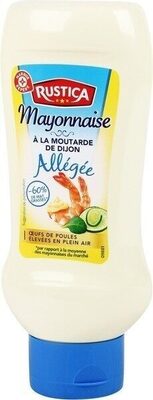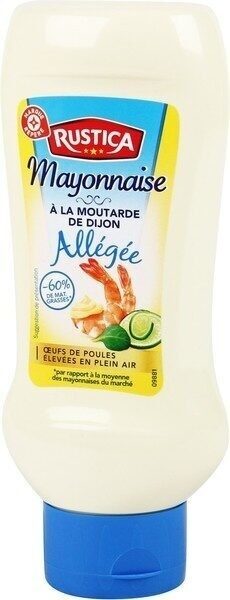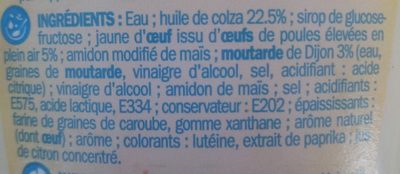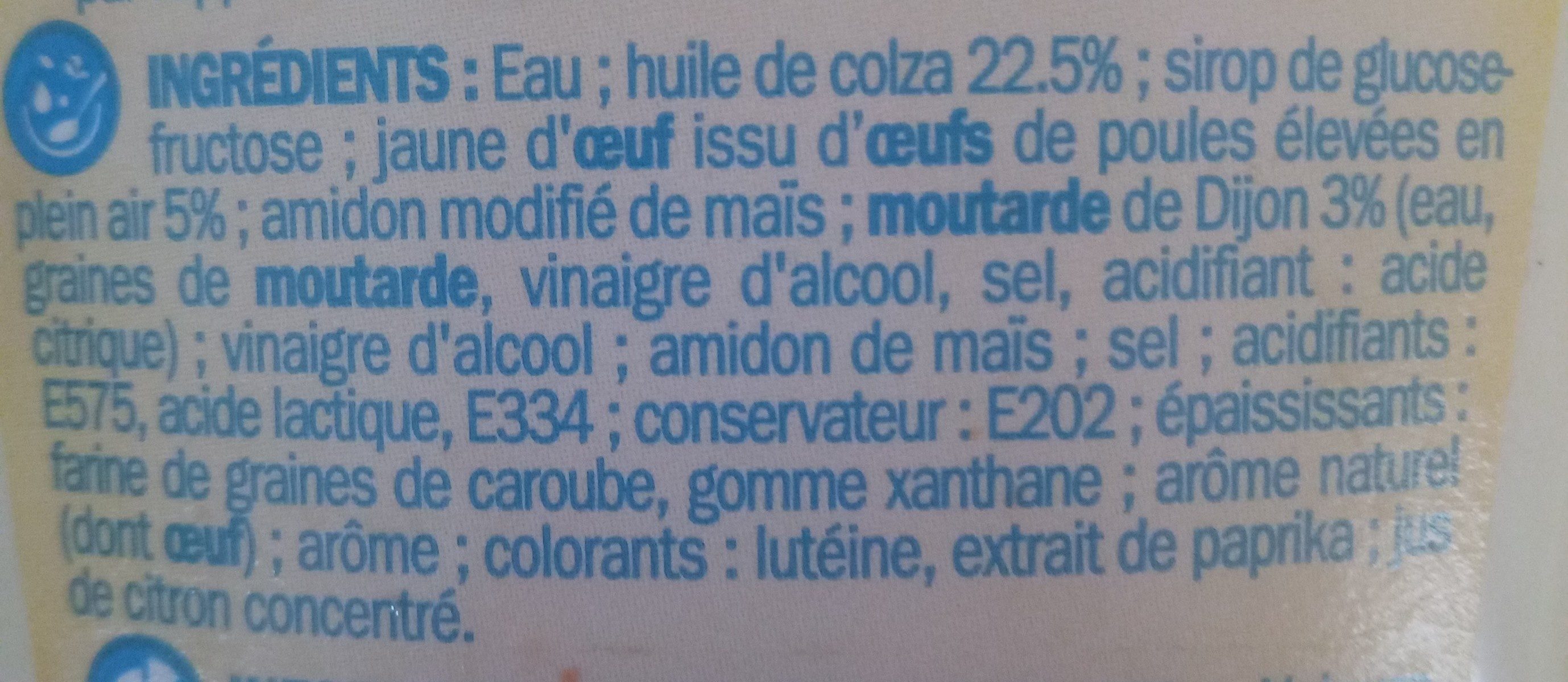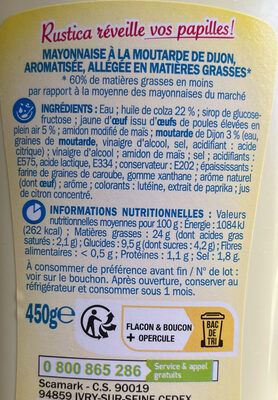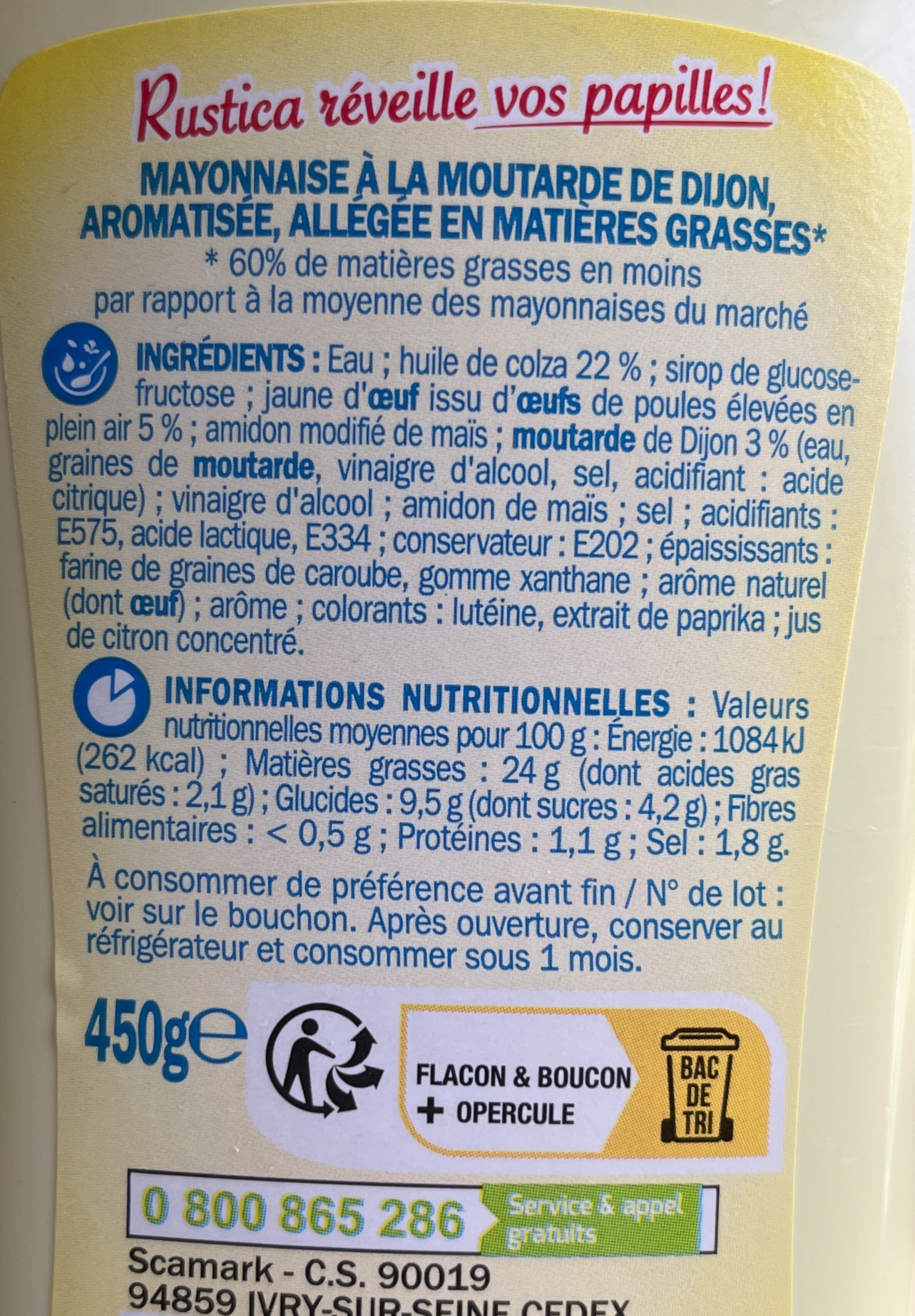Help us make food transparency the norm!
As a non-profit organization, we depend on your donations to continue informing consumers around the world about what they eat.
The food revolution starts with you!
Mayonnaise Allégé à la moutarde de Dijon - Rustica - 450 g
Mayonnaise Allégé à la moutarde de Dijon - Rustica - 450 g
This product page is not complete. You can help to complete it by editing it and adding more data from the photos we have, or by taking more photos using the app for Android or iPhone/iPad. Thank you!
×
Some of the data for this product has been provided directly by the manufacturer Scamark.
Barcode: 3564700633687 (EAN / EAN-13)
Common name: Mayonnaise à la Moutarde de Dijon Allégée en Matières Grasses
Quantity: 450 g
Brands: Rustica, Marque Repère
Categories: Condiments, Sauces, Mayonnaises, Dijon mayonnaises, Light mayonnaises, Groceries
Labels, certifications, awards:
Low or no fat, Low fat, Reduced fat, Green Dot, Triman

Stores: Leclerc
Matching with your preferences
Health
Ingredients
-
31 ingredients
water , rapeseed oil 22.5% , glucose-fructose syrup , egg yolk from free-range eggs 5% , modified corn starch , dijon mustard 3% (water, mustard seeds, alcohol vinegar, salt, acidifier: citric acid) , alcohol vinegar , corn starch , salt , acidifiers: e575, lactic acid, e334 , preservative: e202 , thickeners: carob seed flour, xanthan gum , natural flavor (including egg) , flavoring , colors: lutein, paprika extract , lemon juice concentrateAllergens: Eggs, Mustard, Sulphur dioxide and sulphites
Food processing
-
Ultra processed foods
Elements that indicate the product is in the 4 - Ultra processed food and drink products group:
- Additive: E14XX - Modified Starch
- Additive: E160c - Paprika extract
- Additive: E161b - Lutein
- Additive: E415 - Xanthan gum
- Ingredient: Colour
- Ingredient: Flavouring
- Ingredient: Glucose
- Ingredient: Thickener
Food products are classified into 4 groups according to their degree of processing:
- Unprocessed or minimally processed foods
- Processed culinary ingredients
- Processed foods
- Ultra processed foods
The determination of the group is based on the category of the product and on the ingredients it contains.
Additives
-
E202 - Potassium sorbate
Potassium sorbate (E202) is a synthetic food preservative commonly used to extend the shelf life of various food products.
It works by inhibiting the growth of molds, yeast, and some bacteria, preventing spoilage. When added to foods, it helps maintain their freshness and quality.
Some studies have shown that when combined with nitrites, potassium sorbate have genotoxic activity in vitro. However, potassium sorbate is generally recognized as safe (GRAS) by regulatory authorities.
-
E270 - Lactic acid
Lactic acid: Lactic acid is an organic compound with the formula CH3CH-OH-COOH. In its solid state, it is white and water-soluble. In its liquid state, it is colorless. It is produced both naturally and synthetically. With a hydroxyl group adjacent to the carboxyl group, lactic acid is classified as an alpha-hydroxy acid -AHA-. In the form of its conjugate base called lactate, it plays a role in several biochemical processes. In solution, it can ionize a proton from the carboxyl group, producing the lactate ion CH3CH-OH-CO−2. Compared to acetic acid, its pKa is 1 unit less, meaning lactic acid deprotonates ten times more easily than acetic acid does. This higher acidity is the consequence of the intramolecular hydrogen bonding between the α-hydroxyl and the carboxylate group. Lactic acid is chiral, consisting of two optical isomers. One is known as L--+--lactic acid or -S--lactic acid and the other, its mirror image, is D--−--lactic acid or -R--lactic acid. A mixture of the two in equal amounts is called DL-lactic acid, or racemic lactic acid. Lactic acid is hygroscopic. DL-lactic acid is miscible with water and with ethanol above its melting point which is around 17 or 18 °C. D-lactic acid and L-lactic acid have a higher melting point. In animals, L-lactate is constantly produced from pyruvate via the enzyme lactate dehydrogenase -LDH- in a process of fermentation during normal metabolism and exercise. It does not increase in concentration until the rate of lactate production exceeds the rate of lactate removal, which is governed by a number of factors, including monocarboxylate transporters, concentration and isoform of LDH, and oxidative capacity of tissues. The concentration of blood lactate is usually 1–2 mM at rest, but can rise to over 20 mM during intense exertion and as high as 25 mM afterward. In addition to other biological roles, L-lactic acid is the primary endogenous agonist of hydroxycarboxylic acid receptor 1 -HCA1-, which is a Gi/o-coupled G protein-coupled receptor -GPCR-.In industry, lactic acid fermentation is performed by lactic acid bacteria, which convert simple carbohydrates such as glucose, sucrose, or galactose to lactic acid. These bacteria can also grow in the mouth; the acid they produce is responsible for the tooth decay known as caries. In medicine, lactate is one of the main components of lactated Ringer's solution and Hartmann's solution. These intravenous fluids consist of sodium and potassium cations along with lactate and chloride anions in solution with distilled water, generally in concentrations isotonic with human blood. It is most commonly used for fluid resuscitation after blood loss due to trauma, surgery, or burns.Source: Wikipedia
-
E330 - Citric acid
Citric acid is a natural organic acid found in citrus fruits such as lemons, oranges, and limes.
It is widely used in the food industry as a flavor enhancer, acidulant, and preservative due to its tart and refreshing taste.
Citric acid is safe for consumption when used in moderation and is considered a generally recognized as safe (GRAS) food additive by regulatory agencies worldwide.
-
E334 - L(+)-tartaric acid
Tartaric acid: Tartaric acid is a white, crystalline organic acid that occurs naturally in many fruits, most notably in grapes, but also in bananas, tamarinds, and citrus. Its salt, potassium bitartrate, commonly known as cream of tartar, develops naturally in the process of winemaking. It is commonly mixed with sodium bicarbonate and is sold as baking powder used as a leavening agent in food preparation. The acid itself is added to foods as an antioxidant and to impart its distinctive sour taste. Tartaric is an alpha-hydroxy-carboxylic acid, is diprotic and aldaric in acid characteristics, and is a dihydroxyl derivative of succinic acid.Source: Wikipedia
-
E415 - Xanthan gum
Xanthan gum (E415) is a natural polysaccharide derived from fermented sugars, often used in the food industry as a thickening and stabilizing agent.
This versatile food additive enhances texture and prevents ingredient separation in a wide range of products, including salad dressings, sauces, and gluten-free baked goods.
It is considered safe for consumption even at high intake amounts.
-
E575 - Glucono-delta-lactone
Glucono delta-lactone: Glucono delta-lactone -GDL-, also known as gluconolactone, is a food additive with the E number E575 used as a sequestrant, an acidifier, or a curing, pickling, or leavening agent. It is a lactone of D-gluconic acid. Pure GDL is a white odorless crystalline powder. GDL has been marketed for use in feta cheese. GDL is neutral, but hydrolyses in water to gluconic acid which is acidic, adding a tangy taste to foods, though it has roughly a third of the sourness of citric acid. It is metabolized to 6-phospho-D-gluconate; one gram of GDL yields roughly the same amount of metabolic energy as one gram of sugar. Upon addition to water, GDL is partially hydrolysed to gluconic acid, with the balance between the lactone form and the acid form established as a chemical equilibrium. The rate of hydrolysis of GDL is increased by heat and high pH.The yeast Saccharomyces bulderi can be used to ferment gluconolactone to ethanol and carbon dioxide. The pH value greatly affects culture growth. Gluconolactone at 1 or 2% in a mineral media solution causes the pH to drop below 3.It is also a complete inhibitor of the enzyme amygdalin beta-glucosidase at concentrations of 1 mM.Source: Wikipedia
Ingredients analysis
-
Palm oil free
No ingredients containing palm oil detected
-
Non-vegan
Non-vegan ingredients: Free range chicken egg yolk, Egg
-
Vegetarian status unknown
Unrecognized ingredients: Dijon mustard
-
Details of the analysis of the ingredients
: Eau, huile de colza 22.5%, sirop de glucose-fructose, jaune d'œuf issu d'œufs de poules élevées en plein air 5%, amidon modifié de maïs, moutarde de Dijon 3% (eau, graines de moutarde, vinaigre d'alcool, sel, acidifiant (acide citrique)), vinaigre d'alcool, amidon de maïs, sel, acidifiants (e575), acide lactique, e334, conservateur (e202), épaississants (farine de graines de caroube), gomme xanthane, arôme naturel (dont œuf), arôme, colorants (lutéine), extrait de paprika, jus de citron concentré- Eau -> en:water - vegan: yes - vegetarian: yes - ciqual_food_code: 18066 - percent_min: 22.5 - percent_max: 61.5
- huile de colza -> en:colza-oil - vegan: yes - vegetarian: yes - from_palm_oil: no - ciqual_food_code: 17130 - percent_min: 22.5 - percent: 22.5 - percent_max: 22.5
- sirop de glucose-fructose -> en:glucose-fructose-syrup - vegan: yes - vegetarian: yes - ciqual_food_code: 31077 - percent_min: 5 - percent_max: 22.5
- jaune d'œuf issu d'œufs de poules élevées en plein air -> en:free-range-chicken-egg-yolk - vegan: no - vegetarian: yes - ciqual_food_code: 22002 - percent_min: 5 - percent: 5 - percent_max: 5
- amidon modifié de maïs -> en:modified-corn-starch - vegan: yes - vegetarian: yes - ciqual_food_code: 9510 - percent_min: 3 - percent_max: 5
- moutarde de Dijon -> en:dijon-mustard - ciqual_food_code: 11013 - percent_min: 3 - percent: 3 - percent_max: 3
- eau -> en:water - vegan: yes - vegetarian: yes - ciqual_food_code: 18066 - percent_min: 0.6 - percent_max: 3
- graines de moutarde -> en:mustard-seed - vegan: yes - vegetarian: yes - ciqual_food_code: 11013 - percent_min: 0 - percent_max: 1.5
- vinaigre d'alcool -> en:alcohol-vinegar - vegan: yes - vegetarian: yes - ciqual_food_code: 11018 - percent_min: 0 - percent_max: 1
- sel -> en:salt - vegan: yes - vegetarian: yes - ciqual_food_code: 11058 - percent_min: 0 - percent_max: 0.75
- acidifiant -> en:acid - percent_min: 0 - percent_max: 0.6
- acide citrique -> en:e330 - vegan: yes - vegetarian: yes - percent_min: 0 - percent_max: 0.6
- vinaigre d'alcool -> en:alcohol-vinegar - vegan: yes - vegetarian: yes - ciqual_food_code: 11018 - percent_min: 0 - percent_max: 3
- amidon de maïs -> en:corn-starch - vegan: yes - vegetarian: yes - ciqual_food_code: 9510 - percent_min: 0 - percent_max: 3
- sel -> en:salt - vegan: yes - vegetarian: yes - ciqual_food_code: 11058 - percent_min: 0 - percent_max: 1.8
- acidifiants -> en:acid - percent_min: 0 - percent_max: 1.8
- e575 -> en:e575 - vegan: yes - vegetarian: yes - percent_min: 0 - percent_max: 1.8
- acide lactique -> en:e270 - vegan: yes - vegetarian: yes - percent_min: 0 - percent_max: 1.8
- e334 -> en:e334 - vegan: yes - vegetarian: yes - percent_min: 0 - percent_max: 1.8
- conservateur -> en:preservative - percent_min: 0 - percent_max: 1.8
- e202 -> en:e202 - vegan: yes - vegetarian: yes - percent_min: 0 - percent_max: 1.8
- épaississants -> en:thickener - percent_min: 0 - percent_max: 1.8
- farine de graines de caroube -> en:carob-seed-flour - vegan: yes - vegetarian: yes - ciqual_proxy_food_code: 9410 - percent_min: 0 - percent_max: 1.8
- gomme xanthane -> en:e415 - vegan: yes - vegetarian: yes - percent_min: 0 - percent_max: 1.8
- arôme naturel -> en:natural-flavouring - vegan: maybe - vegetarian: maybe - percent_min: 0 - percent_max: 1.8
- dont œuf -> en:egg - vegan: no - vegetarian: yes - ciqual_food_code: 22000 - percent_min: 0 - percent_max: 1.8
- arôme -> en:flavouring - vegan: maybe - vegetarian: maybe - percent_min: 0 - percent_max: 1.8
- colorants -> en:colour - percent_min: 0 - percent_max: 1.8
- lutéine -> en:e161b - vegan: yes - vegetarian: yes - percent_min: 0 - percent_max: 1.8
- extrait de paprika -> en:e160c - vegan: yes - vegetarian: yes - percent_min: 0 - percent_max: 1.8
- jus de citron concentré -> en:concentrated-lemon-juice - vegan: yes - vegetarian: yes - ciqual_food_code: 2028 - percent_min: 0 - percent_max: 1.8
Nutrition
-
Poor nutritional quality
⚠ ️Warning: the amount of fruits, vegetables and nuts is not specified on the label, it was estimated from the list of ingredients: 22This product is not considered a beverage for the calculation of the Nutri-Score.
Positive points: 0
- Proteins: 0 / 5 (value: 1.1, rounded value: 1.1)
- Fiber: 0 / 5 (value: 0.1, rounded value: 0.1)
- Fruits, vegetables, nuts, and colza/walnut/olive oils: 0 / 5 (value: 22.5421875, rounded value: 22.5)
Negative points: 12
- Energy: 3 / 10 (value: 1084, rounded value: 1084)
- Sugars: 0 / 10 (value: 4.2, rounded value: 4.2)
- Saturated fat: 2 / 10 (value: 2.1, rounded value: 2.1)
- Sodium: 7 / 10 (value: 720, rounded value: 720)
The points for proteins are not counted because the negative points are greater or equal to 11.
Nutritional score: (12 - 0)
Nutri-Score:
-
Nutrient levels
-
Fat in high quantity (24.2%)
What you need to know- A high consumption of fat, especially saturated fats, can raise cholesterol, which increases the risk of heart diseases.
Recommendation: Limit the consumption of fat and saturated fat- Choose products with lower fat and saturated fat content.
-
Saturated fat in moderate quantity (2.1%)
What you need to know- A high consumption of fat, especially saturated fats, can raise cholesterol, which increases the risk of heart diseases.
Recommendation: Limit the consumption of fat and saturated fat- Choose products with lower fat and saturated fat content.
-
Sugars in low quantity (4.2%)
What you need to know- A high consumption of sugar can cause weight gain and tooth decay. It also augments the risk of type 2 diabetes and cardio-vascular diseases.
Recommendation: Limit the consumption of sugar and sugary drinks- Sugary drinks (such as sodas, fruit beverages, and fruit juices and nectars) should be limited as much as possible (no more than 1 glass a day).
- Choose products with lower sugar content and reduce the consumption of products with added sugars.
-
Salt in high quantity (1.8%)
What you need to know- A high consumption of salt (or sodium) can cause raised blood pressure, which can increase the risk of heart disease and stroke.
- Many people who have high blood pressure do not know it, as there are often no symptoms.
- Most people consume too much salt (on average 9 to 12 grams per day), around twice the recommended maximum level of intake.
Recommendation: Limit the consumption of salt and salted food- Reduce the quantity of salt used when cooking, and don't salt again at the table.
- Limit the consumption of salty snacks and choose products with lower salt content.
-
-
Nutrition facts
Nutrition facts As sold
for 100 g / 100 mlCompared to: Dijon mayonnaises Energy 1,084 kj
(262 kcal)-60% Fat 24.2 g -66% Saturated fat 2.1 g -66% Carbohydrates 9.5 g +311% Sugars 4.2 g +190% Fiber 0.1 g -74% Proteins 1.1 g -20% Salt 1.8 g +21% Fruits‚ vegetables‚ nuts and rapeseed‚ walnut and olive oils (estimate from ingredients list analysis) 22.542 %
Environment
-
Eco-Score D - High environmental impact
⚠ ️Select a country in order to include the full impact of transportation.The Eco-Score is an experimental score that summarizes the environmental impacts of food products.→ The Eco-Score was initially developped for France and it is being extended to other European countries. The Eco-Score formula is subject to change as it is regularly improved to make it more precise and better suited to each country.Life cycle analysis
-
Average impact of products of the same category: C (Score: 54/100)
Category: Mayonnaise, reduced fat or light mayonnaise
Category: Mayonnaise, reduced fat or light mayonnaise
- PEF environmental score: 0.50 (the lower the score, the lower the impact)
- including impact on climate change: 3.01 kg CO2 eq/kg of product
Stage Impact Agriculture
72.4 %Processing
13.6 %Packaging
5.3 %Transportation
6.3 %Distribution
1.9 %Consumption
0.5 %
Bonuses and maluses
-
Missing origins of ingredients information
Malus: -5
⚠ ️ The origins of the ingredients of this product are not indicated.
If they are indicated on the packaging, you can modify the product sheet and add them.
If you are the manufacturer of this product, you can send us the information with our free platform for producers.
-
Packaging with a medium impact
Malus: -12
Shape Material Recycling Impact Vial Plastic High Bottle cap Unknown High Seal Unknown High ⚠ ️ The information about the packaging of this product is not sufficiently precise (exact shapes and materials of all components of the packaging).⚠ ️ For a more precise calculation of the Eco-Score, you can modify the product page and add them.
If you are the manufacturer of this product, you can send us the information with our free platform for producers.
Eco-Score for this product
-
Impact for this product: D (Score: 37/100)
Product: Mayonnaise Allégé à la moutarde de Dijon - Rustica - 450 g
Life cycle analysis score: 54
Sum of bonuses and maluses: -17
Final score: 37/100
-
Carbon footprint
-
Equal to driving 1.6 km in a petrol car
301 g CO² per 100g of product
The carbon emission figure comes from ADEME's Agribalyse database, for the category: Mayonnaise, reduced fat or light mayonnaise (Source: ADEME Agribalyse Database)
Stage Impact Agriculture
65.3 %Processing
13.0 %Packaging
8.0 %Transportation
12.2 %Distribution
1.3 %Consumption
0.2 %
Packaging
-
Packaging with a medium impact
-
Packaging parts
Vial (Plastic)
Bottle cap
Seal
-
Packaging materials
Material % Packaging weight Packaging weight per 100 g of product Plastic
-
Transportation
-
Origins of ingredients
Missing origins of ingredients information
⚠ ️ The origins of the ingredients of this product are not indicated.
If they are indicated on the packaging, you can modify the product sheet and add them.
If you are the manufacturer of this product, you can send us the information with our free platform for producers.Add the origins of ingredients for this product Add the origins of ingredients for this product
Report a problem
-
Incomplete or incorrect information?
Category, labels, ingredients, allergens, nutritional information, photos etc.
If the information does not match the information on the packaging, please complete or correct it. Open Food Facts is a collaborative database, and every contribution is useful for all.
Data sources
Product added on by openfoodfacts-contributors
Last edit of product page on by teolemon.
Product page also edited by beniben, date-limite-app, ecoscore-impact-estimator, inf, itsjustruby, kiliweb, org-scamark, packbot, quentinbrd, scamark, scanbot, sebleouf, segundo, yuka.SExBeUFwc1BnZXNoaTg4Wm9SRGUyZk1sd0tYNWR6eVRLUE1ZSVE9PQ, yuka.SGYwckY2SUNudVphdXNOazB5TEl5dTB2bjd1cmVrT3Zkc1lOSVE9PQ, yuka.U3Ewd1FiUVI5K0l2cS9jZTNFaVArOUp0Mjc2d1dVMllFTElYSWc9PQ, yuka.UkswRU42QXJwc0JibnZBQytVL0grdEI3L3FldFhsNmxGZU5LSUE9PQ, yuka.VElZRE9ZQXZtTjRqbWZRRTFUUDQ0Zmwyelo2a0FtK1lHc1VNSWc9PQ, yuka.WHFVbUxhSWdodjRSaGNadW96S01wZHN0MzZHdFF6N29Oc2swSVE9PQ, yuka.ZmF3Uk1KNHRsOEVCaXNZUjh6cnA4OTVNd283MFdWT0xkdEU0SVE9PQ, yuka.sY2b0xO6T85zoF3NwEKvlmxDS8HDqDn6PRv4wWPXnI2ECcP5Tt1844Sqbao, yuka.sY2b0xO6T85zoF3NwEKvlnBaUd_HnRaVPR7kxxKm4P3QDZ7ISMFp0KLVD6s, yuka.sY2b0xO6T85zoF3NwEKvlndsdd38_hzGbDfvgnex1NWSHpP5QdJ75NDCb6s.
